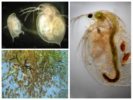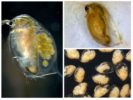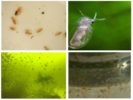- Water fleas
- Daphnia
- Growing daphnia
Fans of guessing scanwords know that water fleas are called Daphnia. These small crustaceans are very similar in appearance to blood-sucking parasites and make sharp original tremors in the water. However, this is the similarity of aquatic creatures with true fleas ends. Daphnia does not drink blood, does not parasitize on animals, fish, and most often they themselves are food for waterfowl.
How water fleas look and live
Daphnia belong to the genus of crustacean planktonic. On the head there are branched tendrils, which is why the taxonomy classifies them as an order of the branched. They live everywhere, including Antarctica. You can meet their populations in any body of water, whether it be a puddle, a pond, a lake, a river. The water flea spends the cold season in the bottom layer. With the onset of heat, it activates and, under favorable conditions, begins to multiply rapidly.
There are more than 150 species of daphnia, which may have a different color, body length. In the CIS, such species as galeate, cristate, pullex, magna are common. The sizes of daphnia vary in the range of 0.5-6 mm. The body is covered with a transparent shell fastened on the back. The antennae, covered with bristles, help the water flea move and make vertical movements in the water column.
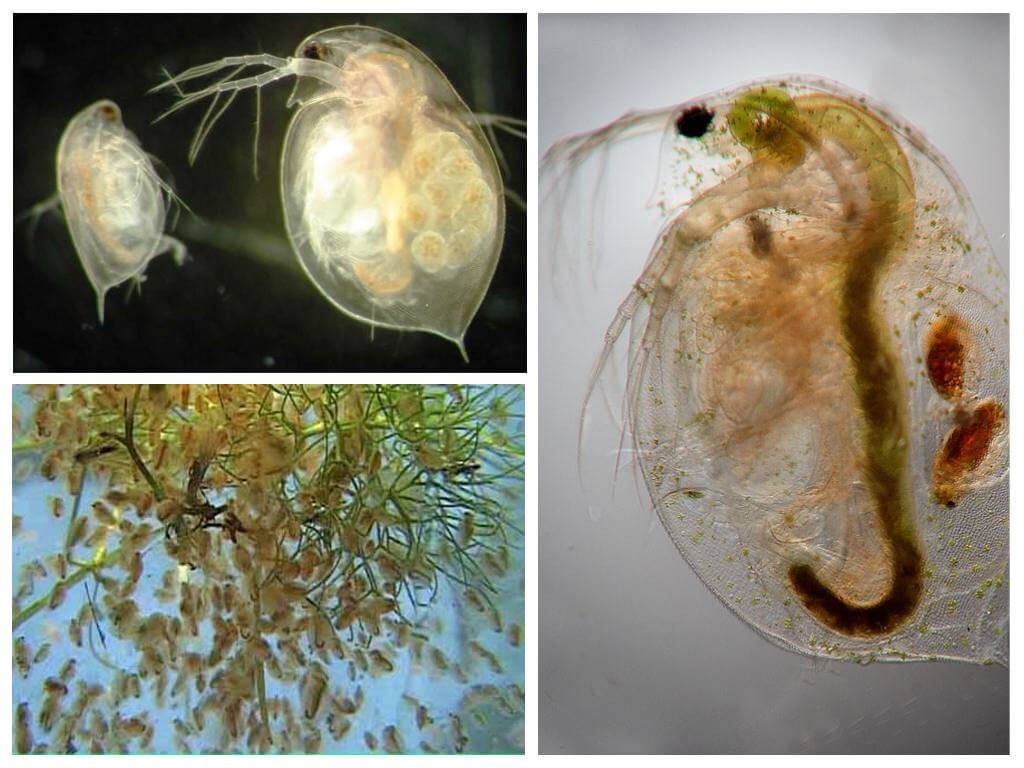
In addition to antennas, there is one moving eye on the head, consisting of several small eyes, a cranberry outgrowth - rostrum. Due to the transparency of the body, you can use a microscope or a photo to examine in detail the internal structure. The heart of Daphnia is located on the dorsal part, the kidneys are in the upper part of the body, and the brain is located near the esophagus.
Interesting!
Daphnia magna’s heart rate reaches 180 beats per second. Weak heart contractions indicate a painful condition of the crustacean.
Water fleas in the photo, even if they belong to the same species, may vary in color. The color of Daphnia depends on how rich in oxygen the pond is. With its excess, they are light yellowish or gray in color. If oxygen deficiency is observed in the reservoir, the body becomes dark brown.
What do water fleas eat?
In the natural environment, crustaceans feed on the simplest organisms: ciliates, bacteria, fungal spores, free-floating algae. In the summer, they can be found in flowering water, abundant in phytoplankton. In winter, detritus is the source of nutrition for water fleas.
With the help of the legs, the crustaceans make rhythmic movements and create a water current. The bristles located on the chest legs filter the food. Then it enters the groove, after which it is redirected to the esophagus. Due to its nutritional characteristics, a Daphnia culture is often planted in an aquarium to purify water from algae.
Interesting!
For one day, one individual is able to filter from 1 to 10 ml of feed in water and consume an amount of food that is 6 times its own weight.
Propagation of water fleas
In the presence of a food base, the eggs of a female develop without male intervention. Embryos develop in a special chamber located under the sink. You can see them in the body of a female even without a magnifying glass. The number of juveniles varies from 5 to 10. Over the course of her life, the female is able to give life to 100 crustaceans.During the period in the chamber, the embryos are molted.
Interesting!
Generation of a female during parterogenesis always has one gender. In summer, ponds overrun young females, and in the autumn, males develop predominantly.
3-4 days are enough for a newborn female to be able to replenish the reservoir with her offspring, and given that in the hot period exclusively female individuals are born, population growth is rapid.
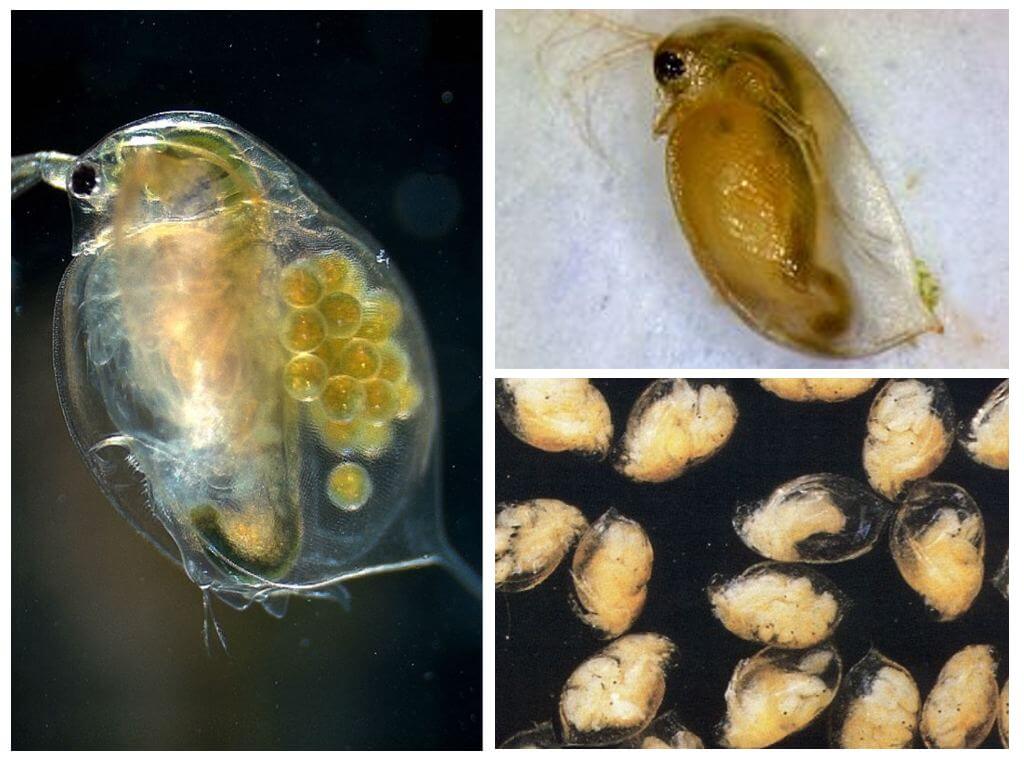
The process of bisexual reproduction is possible with a decrease in temperature and an insufficient amount of food. Embryos are in the chamber and protected by a dense chitinous cover. During molting, the female drops the capsule with eggs, and it either sinks to the bottom or swims in the upper layer of water. The dense shell maintains the viability of the embryos during freezing, high temperatures, in toxic solutions.
The benefits and harms of water fleas
Contrary to the erroneous opinion, Daphnia are not able to bite a person, their mouth apparatus is absolutely not suitable for this. Water fleas are used as food for aquarium fish. Depending on the species, nutritional conditions, crustaceans contain from 50 to 70% protein. They are given to fishes in fresh, frozen or dried form.
You can catch “live food” in any body of water by means of a net or establish production at home. Water fleas in the aquarium will serve not only as food, but also purify the water.
The harm of crustaceans lies in their allergenicity. During flowering, pollen is carried by the wind and into water bodies. Daphnia during the filtration process passes it through itself, as a result of which the allergen accumulates in them. During the drying process, pollen stays and provokes strong allergic reactions, which are mistaken for bites.
Signs of an allergy to daphnia:
- the appearance of a rash on the body, similar in nature to hives;
- severe itching;
- sneezing, nasal congestion;
- labored breathing;
- lacrimation, eye inflammation.
Only a doctor can perform an accurate diagnosis on the basis of a skin test. Antihistamines, inhalers are prescribed depending on the severity of the symptoms.
Growing Water Fleas
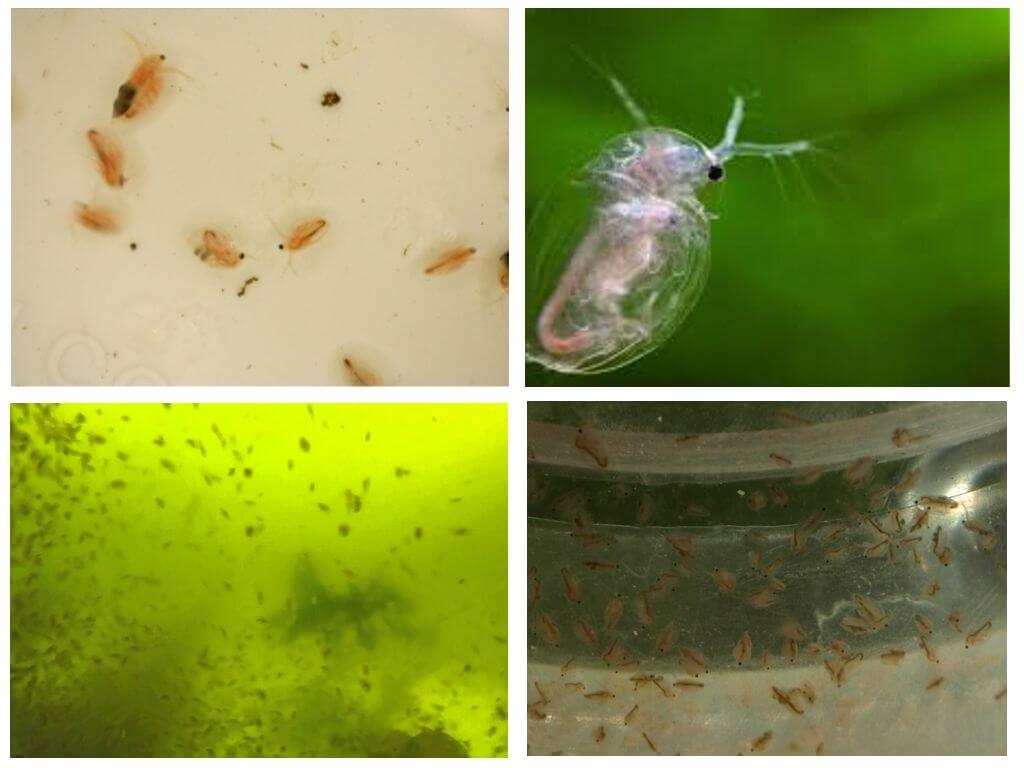
To provide the inhabitants of the aquariums with ecologically clean food, daphnia is grown at home:
- First of all, it is necessary to prepare a tank in which crustaceans will breed. It can be any plastic container suitable for food, plastic bottles from under drinking water are often used.
- Crustaceans are not particularly demanding on the composition of water. The main thing is that there should be no impurities of salts or metal compounds in it.
- Yeast and green algae are used as food. The latter are actively developing in the sunlight. It is enough to put a bottle filled with water with a microalgae culture in a warm place, as already after 10-14 days it will be possible to feed the water fleas with their own hand grown food.
- In order for the crustaceans to actively reproduce, it is necessary to create favorable conditions for them: a temperature of 23-25 ° C and 24 hours of daylight.
- Periodically, the Daphnia culture and water are renewed.
The highest nutritional value of fresh water fleas. When frozen, they lose some of the enzymes and amino acids.
